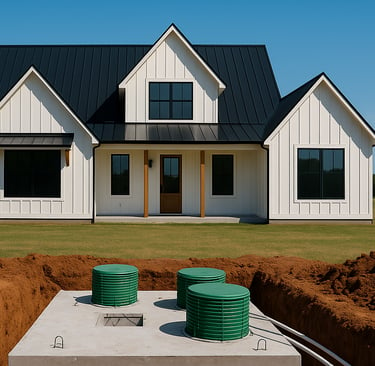Septic Systems: What You Need to Know
Costs, Feasibility, and Permitting Tips for North Texas Land Buyers
6/1/20254 min read


Septic Systems: What You Need to Know
Costs, Feasibility, and Permitting Tips for North Texas Land Buyers
When buying rural or semi-rural land in North Texas with the intention of building a custom home, one of the most critical—but often overlooked—components of your property planning is the septic system. In areas where municipal sewer services don’t extend, a properly installed and permitted septic system becomes essential for managing household wastewater.
If you’re new to this, don’t worry. In this article, we’ll walk you through what a septic system is, how to determine if land is suitable for one, what types of systems are available, typical installation costs, and how to navigate local regulations and permitting in North Texas.
What Is a Septic System and Why Does It Matter?
A septic system is an on-site wastewater treatment solution used on properties without access to a city sewer line. It collects everything that goes down your drains—sinks, toilets, showers—and processes it underground.
A functioning septic system is critical for health, safety, and environmental protection. Without one, you can’t legally or safely build a home on land that lacks sewer access. That’s why understanding septic feasibility should be part of your due diligence before purchasing land.
Step One: Is the Land Suitable for a Septic System?
Before closing on a piece of property, you’ll want to assess whether a septic system can be installed—and which type. This is typically done through a soil test, also known as a Site Evaluation or Percolation Test (Perc Test). A licensed site evaluator or engineer will dig small holes in various parts of the land and examine the soil composition, depth, drainage characteristics, and slope.
Some factors that affect feasibility:
Soil Type: Sandy or loamy soils usually drain well, while clay-heavy soils may not.
Water Table Level: High groundwater can limit options or require more advanced systems.
Lot Size and Shape: Smaller or irregular lots can make system layout more complex.
Proximity to Water Sources: Setback requirements from wells, creeks, or ponds must be met.
Tip: In many North Texas counties, a minimum of one acre is often required for a conventional septic system, though this varies.
Types of Septic Systems Common in North Texas
Once you’ve confirmed a system can be installed, the next question is: what kind?
1. Conventional (Gravel or Pipe) System
Best for: Well-draining soils with adequate space.
Pros: Lower cost, less maintenance.
Cons: Requires favorable soil and topography.
2. Aerobic Treatment Unit (ATU)
Best for: Clay-heavy soils or lots that don’t meet minimum space for conventional systems.
Pros: Can be installed on smaller or more difficult lots.
Cons: Higher upfront cost, requires routine maintenance and ongoing electrical use.
3. Low-Pressure Dosing (LPD) or Drip Systems
Best for: Challenging soil or slope conditions.
Pros: Allows for more flexibility in land use.
Cons: Higher installation and maintenance costs.
Installation Costs: What to Expect
In North Texas, costs vary based on system type, soil conditions, and contractor rates, but here are some general guidelines:
System TypeEstimated CostConventional System$5,000 – $12,000Aerobic System$10,000 – $20,000Drip or LPD System$15,000 – $30,000+
Note: These are estimates for residential use (3-4 bedroom homes). Costs can fluctuate depending on specific site challenges.
Don’t forget to factor in ongoing maintenance—aerobic systems, for example, often require service contracts ($200–$500 per year), regular pump-outs, and replacement of parts like air compressors over time.
Permitting Process in North Texas
Every septic system must be permitted by the local county or regional health authority. Here’s how it typically works:
Hire a Licensed Site Evaluator – They’ll perform the soil test and help determine what type of system is required.
Hire a Licensed Designer – They will draw a system layout based on your home design, land, and soil evaluation.
Submit a Permit Application – With the design and supporting documents, submit to the county or authority (Fannin County, for example).
County Approval – Once reviewed and approved, you’re cleared to begin installation.
Inspection – The system is inspected upon completion to ensure it meets state and local requirements.
Permits are required before any excavation or construction begins. Failure to comply can result in major delays or legal issues down the road.
Tips for Septic Success as a Land Buyer
Request a soil evaluation before purchasing the land, or make the offer contingent on passing one.
Ask for copies of any existing septic permits or drawings if the lot has been previously developed.
Consult local professionals, including your builder, site evaluator, and a septic installer early in the process.
Plan your house location and driveway around the septic and reserve areas (a backup drain field location is often required).
Be aware of distance requirements from wells, property lines, and bodies of water.
Final Thoughts: Don’t Let Septic Be an Afterthought
For many rural homes in North Texas, septic systems are simply part of the infrastructure—but they need to be approached with planning and care. Whether you’re dreaming of a modern farmhouse, barndominium, or custom build on acreage, understanding your land’s wastewater options is crucial.
At NTX Land, we specialize in developing residential lots with utilities like water and electricity already available—and we’ll always let you know if a lot requires septic and what options are feasible. We believe in helping our buyers make informed decisions, every step of the way.
Have questions about septic feasibility on one of our available properties?
Contact us at info@ntx.land or send us a message—we’re happy to help.


